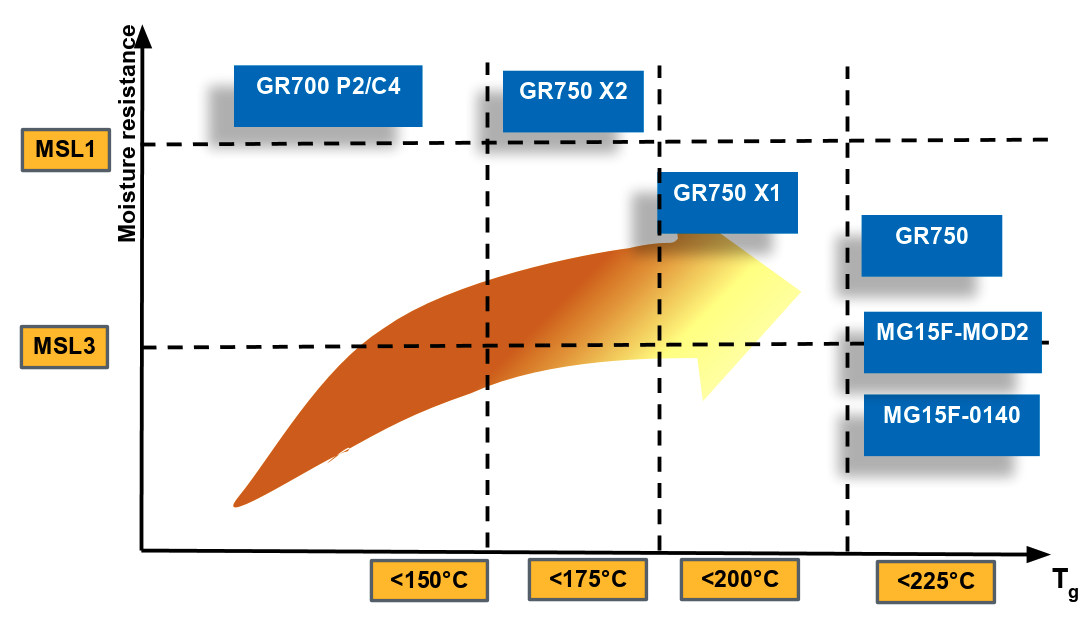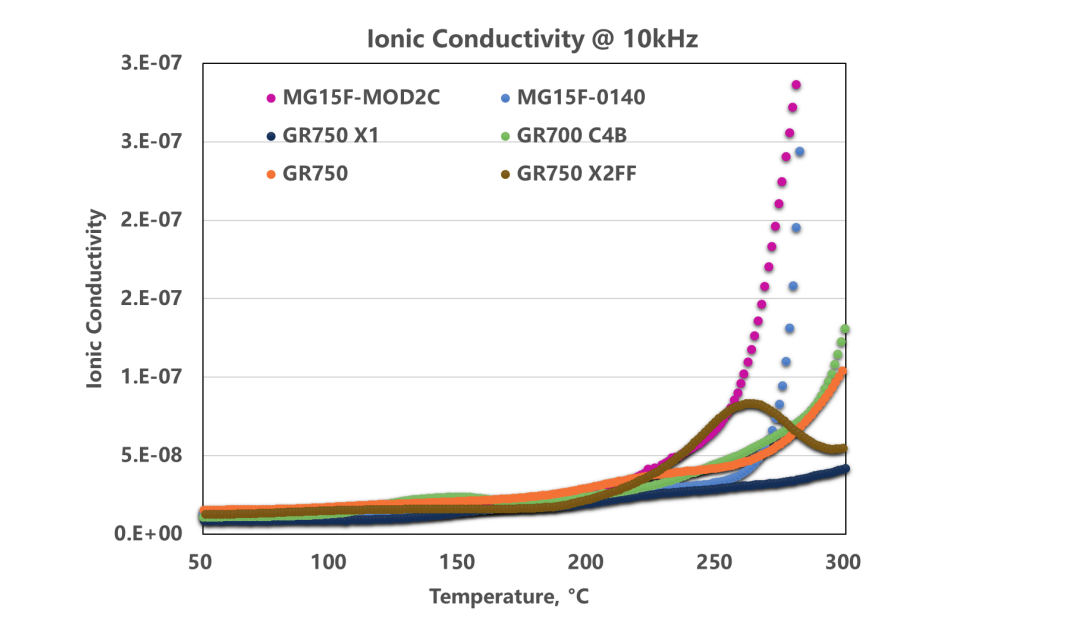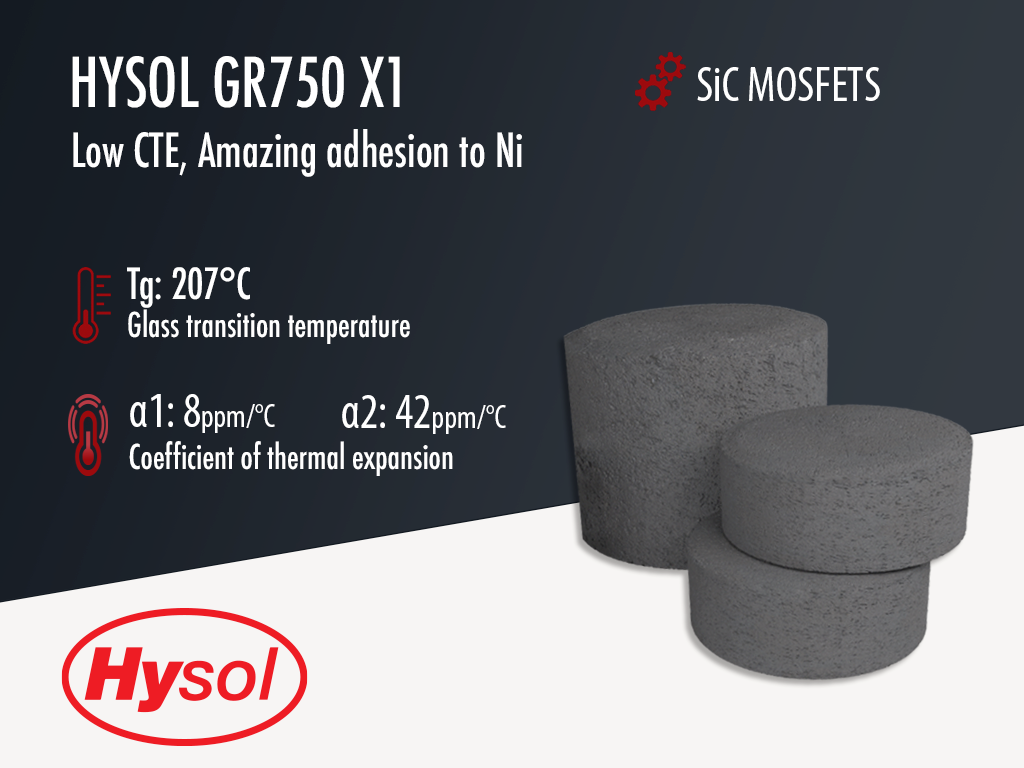Hysol GR750 X1 | Black Epoxy Mold Compound
- Halogen free
- Low CTE: 8 ppm/°C
- Amazing adhesion to Nickel (Ni) leadframes
Product Description
Hysol GR750 X1 is a halogen free, black, silica filled (150um cut size) semiconductor grade epoxy molding compound. It has amazing pull tab adhesion on Nickel (194 N) and on Cu (380 N after PMC and 350N after MSL3)) and very low CTE (10 ppm/°C). It's a very all around product that balances High Tg with low CTE and amazing adhesion. The entire GR75XX product line is alterations to the same formulation to the fit everybody's needs and X1 hits a balanced sweet spot. Its comparative tracking index (CTI) is 600V. The product is still in active development so some properties might end up higher or lower depending on the state of the final formulation. There is also a Low CTE (6 ppm/°C) lab version lurking around. Contact us if you're interested.
Hysol GR750 X1 is a technologically advanced, non anhydride, green epoxy molding compound with excellent electrical performance, designed for high power devices especially for high temperature application with low moisture absorption requirements. It has achieved MSL 3 but we haven't been able to achieve MSL 1, yet. Typical packages can be Silicon Carbide SiC MOSFETS packages in TO 247 and TO 263 among (us) others. HYSOL GR750 X1 has been formulated to provide the best possible moldability and as wide as molding latitude as possible. Renewable energy, EV battery chargers, High voltage DC/DC converters and Switch Mode Power Supplies are only some of the applications where these packages can be used. GR750 X1 delivers outstanding performance and ease of use. It meets UL 94 V-0 flammability at 1/8 inch thickness.
Technical Specifications
| General Properties | |||||||||
| Color Color The color | Black | ||||||||
| Filler Content | 83-85 % | ||||||||
| Specific Gravity Specific Gravity Specific gravity (SG) is the ratio of the density of a substance to the density of a reference substance; equivalently, it is the ratio of the mass of a substance to the mass of a reference substance for the same given volume. For liquids, the reference substance is almost always water (1), while for gases, it is air (1.18) at room temperature. Specific gravity is unitless. | 1.92 | ||||||||
| |||||||||
| Physical Properties | |||||||||
| Spiral Flow @ 175°C | 92 cm | ||||||||
| Chemical Properties | |||||||||
| |||||||||
| Moisture absorption | 0.3 % | ||||||||
| Electrical Properties | |||||||||
| |||||||||
| Volume Resistivity Volume Resistivity Volume resistivity, also called volume resistance, bulk resistance or bulk resistivity is a thickness dependent measurement of the resistivity of a material perpendicular to the plane of the surface. | 1.1x1016 Ohms⋅cm | ||||||||
| Mechanical Properties | |||||||||
| |||||||||
| |||||||||
| |||||||||
| |||||||||
| Thermal Properties | |||||||||
| |||||||||
| |||||||||
| Glass Transition Temperature (Tg) Glass Transition Temperature (Tg) The glass transition temperature for organic adhesives is a temperature region where the polymers change from glassy and brittle to soft and rubbery. Increasing the temperature further continues the softening process as the viscosity drops too. Temperatures between the glass transition temperature and below the decomposition point of the adhesive are the best region for bonding. The glass-transition temperature Tg of a material characterizes the range of temperatures over which this glass transition occurs. | 199 °C | ||||||||
| Thermal Conductivity Thermal Conductivity Thermal conductivity describes the ability of a material to conduct heat. It is required by power packages in order to dissipate heat and maintain stable electrical performance. Thermal conductivity units are [W/(m K)] in the SI system and [Btu/(hr ft °F)] in the Imperial system. | 0.8 W/m.K | ||||||||
| UL 94 Rating UL 94 Rating Flammability rating classification. It determines how fast a material burns or extinguishes once it is ignited. HB: slow burning on a horizontal specimen; burning rate less than 76 mm/min for thickness less than 3 mm or burning stops before 100 mm V-2: burning stops within 30 seconds on a vertical specimen; drips of flaming particles are allowed. V-1: burning stops within 30 seconds on a vertical specimen; drips of particles allowed as long as they are not inflamed. V-0: burning stops within 10 seconds on a vertical specimen; drips of particles allowed as long as they are not inflamed. 5VB: burning stops within 60 seconds on a vertical specimen; no drips allowed; plaque specimens may develop a hole. 5VA: burning stops within 60 seconds on a vertical specimen; no drips allowed; plaque specimens may not develop a hole | V0 | ||||||||
| Curing Conditions | |||||||||
| |||||||||
| |||||||||
| Transfer Time | 6-18 s | ||||||||
Additional Information
GR750 X1 Reliability test results
Package type: TO247
Leadframe: Cu/Ni
Test Item | Parameters | Sample quantity | Test period | Criteria | Test Result |
HTRB | TA=175°C @ 80% of | 77pcs | 168/500/1000 hrs | JESD22-A108D | PASS |
TC | -55℃,15 mins; 150℃,15mins. | 77pcs | 200/500/1000 cycles | JESD22-A104D | PASS |
AC | TA=121℃±2℃, RH=100%,P=15PSIG | 77pcs | 96 hrs | JESD22-A102D | PASS |
HAST | 130°C, 85%RH @80% of Max VR up to 42V | 77pcs | 96 hrs | JESD22-A110D | PASS |
H3TRB | 85°C, 85%RH @80% of Max VR up to 100V | 77pcs | 1000 hrs | JESD22-A101C | PASS |
Post mold curing conditions and how they affect the final properties
| PMC condition | Tg by TMA | CTE 1 | CTE 2 | Storage modulus at RT | Storage modulus at 175 | Storage modulus at 260 | Tg by loss modulus peak | Tg by tand peak |
| 175C*4h | 176 | 11 | 39 | 21784 | 11671 | 1507 | 180 | 199 |
| 190C*10h | 192 | 10 | 33 | 22596 | 17002 | 1608 | 199 | 210 |
| 175C*24h | 192 | 11 | 36 | 23843 | 18427 | 1655 | 197 | 205 |
Comparison of the entire GR7XXX product series

Product Name | MG15F-MOD2 | MG15F-0140 | GR750 (Std) | GR750 X1 (Std) | GR750X1 | GR720X2 (Std) | GR750 X2FF | GR720X2 (high CTE) | ||
|---|---|---|---|---|---|---|---|---|---|---|
Epoxy type | - | OCN/BisA/DCPD | OCN/BisA | MFN | MFN/L.W.A. | MFN/L.W.A. | MFN/L.W.A. | MAR | MAR/L.Vis. | |
Hardener type | - | Anhydride | Anhydride | New | New | New | New | New | New | |
Filler cut size | µm | 106 | 150 | 75 | 75 | 75 | 75 | 45 | 75 | |
Flammability | UL-94 | V-0 at ¼” | V-0 at 1/8'' | V-0 at 1/8'' | V-0 at 1/8'' | V-0 at 1/8'' | V-0 at 1/8'' | V-0 at 1/8'' | V-0 at 1/8'' | |
Spiral Flow | inches | 36 | 20 | 42 | 36 | 26 | 45 | 40 | 41 | |
Gel Time | sec | 32 | 17 | 26 | 24 | 29 | 30 | 30 | 35 | |
Viscosity @ 175°C | PaS | 20 | 28 | 10 | 13 | 43 | 25 | 20 | 15 | |
Tg by TMA | oC | 242 | 195 | 225 | 202 | 197 | 170 | 182 | 170 | |
CTE 1 | ppm/°C | 16 | 21 | 10 | 8 | 6 | 9 | 9 | 14 | |
CTE 2 | ppm/°C | 49 | 70 | 40 | 42 | 31 | 35 | 32 | 40 | |
DMA Storage Modulus at RT | MPa | 18246 | 14078 | 20560 | 23155 | 29241 | 21631 | 23391 | 20971 | |
DMA Storage Modulus at 260C | MPa | 6491 | 1883 | 1658 | 1713 | 1711 | 907 | 1007 | 961 | |
Tg by DMA Tanδ Peak | 0C | 270 | 217 | 235 | 207 | 200 | 177 | 182 | 177 | |
Flexural modulus | Mpa | 16312 | 12449 | 16880 | 18042 | 21469 | 17470 | 17549 | 16900 | |
Flexural strength | Mpa | 120 | 126 | 138 | 136 | 134 | 152 | 169 | 150 | |
Moisture absorption PCT24h | % | 0.55 | 0.65 | 0.35 | 0.3 | 0.2 | 0.2 | 0.2 | 0.2 | |
Cl-/ Na+ | ppm | <10 | <10 | <15 | <15 | <15 | <15 | <15 | <15 | |
PH |
| 4~6 | 4~6 | 5~7 | 5~7 | 5~7 | 5~7 | 5~7 | 5~7 | |
Volume resistivity @21C & 500V | Ω.cm | 2.4E+16 | 6.3E+16 | 3.3E+16 | 1.1E+16 | 1.0E+16 | 1.6E+16 | 1.8E+16 | 1.0E+16 | |
Dielectric constant, 21 C & 1MHz |
| 3.6 | 3.7 | 3.7 | 3.7 | 3.7 | 3.8 | 3.8 | 3.9 | |
Adhesion (tabpull) after MSL3 | on Cu | N | 344 | 136 | 365 | 380 | 307 | 360 | 407 | 331 |
on Ag | N | 235 | NA | 345 | 363 | 269 | 234 | 348 | 415 | |
on Ni | N | 84 | 111 | 170 | 194 | 130 | 104 | 102 | 110 | |
Comparative Tracking Index | V | 600 | 400 | 600 | 600 | 600 | 600 | 600 | 600 | |
Recommended Molding condition | 190°C110s | 180°C100s | 180°C 90s | 180°C 90s | 180°C 90s | 180°C 90s | 180°C 90s | 180°C 90s | ||
Recommended PMC condition | 190°C 3~6hrs | 190°C 3~6hrs | 190°C10hrs | 190°C10hrs | 190°C10hrs | 190°C10hrs | 190°C10hrs | 190°C10hrs | ||

DETA Data for the GR7XX product line
DMA and TMA Curves of GR750-X1




